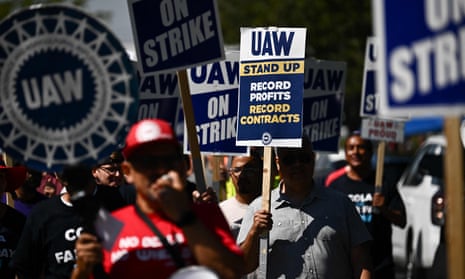The United Auto Workers has claimed its strike against the big three US automakers is working, as it announced General Motors had made concessions during talks.
As the strike strike enters its fourth week, the UAW trailed “breaking developments” at the negotiating table before a briefing on Friday afternoon.
UAW president Shawn Fain, wearing a shirt with the slogan “Eat the Rich”, started a livestream with the announcement that the threat of a strike against GM has led to an agreement for the company to place its electrical-battery manufacturing under the national master agreement with the union.
“GM has been falling behind. Today, under the threat of a major financial hit, they leapfrogged the pack in terms of a just transition,” said Fain. “Our strike is working, but we’re not there yet.”
He added: “In just three weeks, we have moved these companies further than anyone thought possible.”
Ford is ahead of Stellantis and General Motors on their wage offers to the union, Fain said. He added that Ford and Stellantis have agreed to reinstate a cost-of-living allowance. This was lost as part of concessions made to help the industry out of the 2008 economic recession, and had yet to be reinstated.
Fain and autoworkers have positioned the strikes as a broader fight against corporate greed. They have been backed by Democratic elected officials, who argue workers’ wages are lagging behind exorbitant executive pay and billions of dollars in corporate profits.
“The billionaires and company executives think we autoworkers are just dumb. They think we don’t get it. They think we only understand the power of a supervisor yelling at us, or an assembly line coming at us,” said Fain. “We expect results at every company, and we’ve been crystal clear about how you catch a strike and how you avoid one.”
During the livestream, Fain did not announce any additional strikes to the 25,000 workers currently on strike.
About 13,000 auto workers at a General Motors plant in Wentzville, Missouri, a Stellantis plant in Toledo, Ohio, and a Ford plant in Wayne, Michigan kicked off the UAW’s “Stand Up” strike against the automakers on 15 September.
The strategy is meant to keep the corporations guessing as the union continues to increase the pressure over demands for substantial wage increases. The UAW is also calling for 2008 concessions – such as cost of-living adjustment increases, retirement pensions and elimination of lower-wage tiers – to be reinstated.
The UAW expanded its strike on 22 September to 38 parts and distribution sites in 20 states at General Motors and Stellantis, forgoing escalations at Ford, where the contract talks have progressed further than the other two automakers.
Last month, Joe Biden joined the UAW picket line in Michigan, become the first sitting president ever to do so.
The strikes have become heated at times, with violence erupting toward picketing workers, including a driver hitting five people on a picket line in Flint.
Last week the UAW expanded the strike with the addition of Ford’s Chicago assembly plant and a GM plant in Lansing, Michigan. Action at Stellantis was not escalated last week due to progress made in talks.
